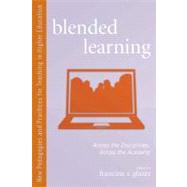Blended Learning
, by Kezar, Adrianna J.- ISBN: 9781579223243 | 1579223249
- Cover: Paperback
- Copyright: 12/30/2011
The book constitutes a practical introduction to blended learning '¬ ; typically involving activities half of which take place face-to-face in a classroom, and half online '¬ ; illustrated by implementations across a broad spectrum of disciplines. It enables faculty unfamiliar with this mode to address the core challenge of blended learning '¬ ; which is to link the activities in each medium so that they reinforce each other to create a single, unified, course '¬ ; and offers models they can adapt. Today'¬"s technologies make it possible to conduct discussions, collaborative writing, assessments, case studies, and other learning activities as easily online as in a classroom, as best suits the instructional design of particular courses. By allowing students to take more time and reflect on the course content, blended learning can promote more student engagement and, consequently, deeper learning; while also appealing to today'¬"s digital natives accustomed to using technology to find and share information, to communicate, and to collaborate, as well as allowing non-traditional students to juggle their commitments more efficiently and successfully. This book takes two findings as its point of departure. First, that online learning, and blended learning in particular '¬ ; when they incorporate active-learning strategies, including opportunities for reflection and interaction with peers '¬ ; can result in significantly better student learning than can be achieved in the conventional classroom. Second, that because they can provide repeated opportunities for students to devote more time on review of information and practice of skills, courses with both synchronous and asynchronous components'¬ ; for example, blended courses'¬ ;report more positive outcomes than do courses that are entirely synchronous or entirely asynchronous. Francine Glazer and the contributors to this book describe how they integrate a wide range of pedagogical approaches in their blended courses; and how they use groups to build learning communities and make the online environment attractive to students. They illustrate under what circumstances particular tasks and activities work best online or face-to-face, and when to incorporate synchronous and asynchronous interactions. They introduce the concept of '¬Slayering'¬ the content of courses to ensure that students see both the online and the face-to-face components as equal in value, and devote equal effort to both modalities; and to appropriately sequence material for beginning and experienced learners. The underlying theme of the book is to encourage students to develop the skills to continue learning throughout their lives.







